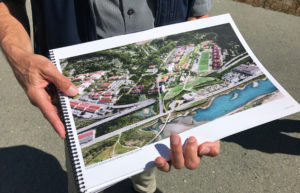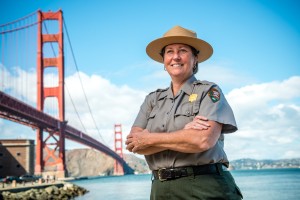For the past 20 years, Mill Valley native Sue Gardner has run the Golden Gate National Parks Conservancy’s Park Stewardship program, connecting people to the Golden Gate National Recreation Area (GGNRA), the nation’s largest urban national park, through volunteer restoration projects, internship programs, citizen science initiatives, and a whole lot more.
JC: What were the early influences that led you to your current career?
SG: I grew up in Mill Valley when it was really still quite wild. There was an intergenerational pod of kids and we’d all play outside — being inside was boring. None of us considered staying inside because it meant having to hang out with our parents, where there was nothing to do. So, growing up with so much open space surrounding me really helped to develop my connection to nature.
Then when I was in high school we had to do 100 hours of community service. I got hooked up with a program that was running a summer camp that was free to kids referred from local social service programs. Everybody who worked at the camp was a volunteer, from the director to the cook to the counselors. They did it to give local youth coming from trying circumstances an opportunity to have a camp experience. We did everything from archery to hiking to arts and crafts — we were outside every day and that’s when the healing and connective power of nature became clear to me. That was a transformative experience for me.
JC: How did you start getting the community involved in stewardship?
SG: I first got started myself up at Point Reyes National Seashore. I was just out of grad school and I was hired onto a project to remove French broom from a wilderness area. It was supposed to take six to eight months, but I was able to do it in two or three months because I started working with the Boy Scout troops and volunteers. It seemed like a win-win: Not only did the work get done twice as fast, but we fired up a group of volunteers that could help maintain these areas over time.
That’s how I became more aware of the value of engaging the community. When I started working here in the Golden Gate National Recreation Area there was already a small group of individuals, the Habitat Restoration Team, who had mobilized to restore and maintain habitat within the park with support from the public.
We’re really blessed compared to many parks that don’t have such an amazing community right at their doorstep. And because we’re so blessed, I feel it’s almost our obligation to invite people in and give them an opportunity to help us care for the park.
JC: Can you tell me about the GGNRA volunteer program, in a nutshell?
SG: The Park Stewardship Program is one of many programs that engage the community within this park. I don’t want it to sound like we’re the only game in town, because there are actually a lot of them.
One thing we do in the stewardship program is active restoration on the landscape. We have one team out there monitoring endangered species, tracking restoration progress, and doing the more technical part of the restoration process. The citizen science aspect of this work is an area where I believe we’re going to see a lot of growth in the future, because people want to be out there helping with the more technical work like data collection.
We have another team that works on connecting volunteers to trail and restoration projects in each of the three counties the park is in: Marin, San Francisco, and San Mateo.
And then we have a whole separate team that runs youth programs. They can spin off and do programs separately, or connect up with all the other volunteer programs in the park, or link up with our park partners. So for instance, this week the youth in our summer programs worked in the historic gardens on Alcatraz, kayaked on Lake Merced, removed graffiti from historic structures in the Marin Headlands, and pulled French broom in Oakwood Valley.
JC: And what’s your role in making all this happen?
SG: My role is to support a brilliant team of staff and interns who then engage the local community in habitat restoration, trail maintenance, and youth programming — it’s pretty big and diverse.
You also asked me about my strengths. I would say I’m a decent volunteer manager, but my real skill is making connections. I get very excited about building partnerships and, through these new relationships, connecting more people into the park.
I also think I’m really good at surrounding myself with talented individuals who bring different skill sets and perspectives — so as a collection we have a broader array of talents than any of us do individually and we can apply this to the programming we co-create.
JC: Has running this program changed the way you look at a landscape?
SG: What I’m really awestruck by is the transformative nature of the landscape for the people who engage in the programs. Our focus has been on connecting volunteers to take care of the land. But what I’ve come to realize is the inverse — how being out in nature transforms people, sometimes without their even realizing it. I’ve witnessed this on so many occasions, particularly with the youth programs.
Many of the youth in our summer programs come from San Francisco and other urban local areas, and we start by taking them to Yosemite for four or five days of camping. They often start out tentative and uncomfortable being away from the lights, Wi-Fi, and the creature comforts of the city. I watch how there’s almost a DNA-level transformation that occurs when people are in nature: It resonates that deeply sometimes. By the end they don’t want to leave.
What’s really neat for me is knowing it’s a two-way street: All the work we’re doing creates a positive impact for the resources, and the natural areas are giving as much back to us, if not more.
JC: What are some of the challenges you face?
SG: I think, for a volunteer manager, the biggest challenge is not burning out. A good volunteer manager puts his or her whole heart into the job — every volunteer is basically a friend, and hosting a volunteer day is like having people over to your house a few times a week. If the manager is connecting with both her head and heart it’s very exhausting over time. So one of the keys has been setting good boundaries, finding ways to reenergize myself, and developing amazing partnerships with others who share the responsibility of caretaking the volunteers.
My challenges have shifted over time because I’m not doing as much one-on-one volunteer management anymore. Now I worry about how to maintain funding and support for the programs over time while supporting the staff and interns. I tend to see opportunities around every corner, so I have to be careful not to overwhelm my team or myself. And I do make a point of getting out into the park once or twice a week so that I can connect with the staff on the ground and to make sure that I’m connected with the resource that I’m ultimately working to restore and connect people to.
JC: What is your favorite thing about the park?
SG: There are two things I really love. First, that our parkland is a public asset: it’s for everyone. That’s part of what we do in stewardship: introduce more people to the parks and invite them to return.
I also love its location. Being so close to the city allows a lot of opportunities for people to get involved. I know of very few cities like San Francisco, which has such an amazing greenbelt surrounding it. We are so lucky.
Just this week I’ve been helping out with our youth programs more than I normally do, and I’ve been so struck with the diversity of habitats and opportunities in this park — the range of cultural and natural resources just blows me away. You can be out one day repairing an old ship used to haul timbers in the Gold Rush era and the next day you can be underground in a battery at Fort Cronkhite or out on Alcatraz helping restore the gardens, or hiking the trail at Dias Ridge above Muir Beach and helping to restore native habitat there.
It’s just a crazy amount of diversity and richness. I hope I can inspire others to come check it out!
Learn more about GGNPC’s Park Stewardship program at bit.ly/ParkStewardship.




-300x221.jpg)
-224x300.jpg)